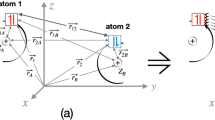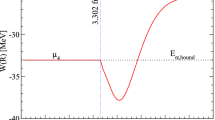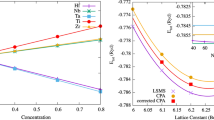Abstract
A range-separated short-range DFT (density functional theory) long-range RPA (random-phase approximation) electron correlation method has been derived that is fully optimised with respect to variations in the orbitals and orbital eigenvalues. The method both exhibits a reduced dependence on the basis set size compared to the full-range RPA correlation method and can be implemented with a computational algorithm which scales only with the fourth power of the molecular size, thus is feasible also for describing large electronic systems. The performance of the functional has been tested for describing the reaction energies of a set of 16 chemical reactions as well as for describing first-order electric properties. In these studies, the influence of the range-separation parameter \(\mu \) on the results has been analysed. Utilising accurate coupled-cluster results as a reference, it will be shown that at values of \(\mu =1.0-2.0\) higher accuracies relative to the full-range DFT functional (corresponding to \(\mu =0\)) on the one hand and the full-range RPA functional (corresponding to \(\mu =\infty \)) on the other hand can be achieved.





Similar content being viewed by others
References
Kohn W, Sham LJ (1965) Self-consistent equations including exchange and correlation effects. Phys Rev 140:A1133
Parr RG, Yang W (1989) Density-functional theory of atoms and molecules. Oxford University Press, Oxford
Perdew JP, Burke K, Ernzerhof M (1996) Generalized gradient approximation made simple. Phys Rev Lett 77:3865. https://doi.org/10.1103/PhysRevLett.77.3865
Tao J, Perdew JP, Staroverov VN, Scuseria E (2003) Climbing the density functional ladder: Nonempirical meta-generalized gradient approximation designed for molecules and solids. Phys Rev Lett 91:146401
Staroverov VN, Scuseria GE, Tao J, Perdew JP (2003) Comparative assessment of a new nonempirical density functional: Molecules and hydrogen-bonded complexes. J Chem Phys 119:12129
Becke AD (1993) A new mixing of Hartree–Fock and local density-functional theories. J Chem Phys 98(2):1372. https://doi.org/10.1063/1.464304
Hamprecht FA, Cohen AJ, Tozer DJ, Handy NC (1998) Development and assessment of new exchange-correlation functionals. J Chem Phys 109:6264
Zhao Y, Truhlar DG (2006) A new local density functional for main-group thermochemistry, transition metal bonding, thermochemical kinetics, and noncovalent interactions. J Chem Phys 125:194101. https://doi.org/10.1063/1.2370993
Shavitt I, Bartlett RJ (2009) Many–body methods in chemistry and physics: MBPT and coupled–cluster theory. Cambridge University Press
McDowell SAC, Amos RD, Handy NC (1995) Molecular polarisabilities—a comparison of density functional theory with standard ab initio methods. Chem Phys Lett 235:1
Tozer DJ, Handy NC (1998) Improving virtual Kohn–Sham orbitals and eigenvalues: application to excitation energies and static polarizabilities. J Chem Phys 109:10180
Galbraith JM, Schäfer HF (1996) Concerning the applicability of density functional methods to atomic and molecular negative ions. J Chem Phys 105:862
Baerends EJ, Gritsenko OV (1997) A quantum chemical view of density functional theory. J Phys Chem A 101:5383
Becke AD (1993) Density-functional thermochemistry. III. The role of exact exchange. J Chem Phys 98(7):5648 https://doi.org/10.1063/1.464913
Becke AD (1996) Density-functional thermochemistry. IV. A new dynamical correlation functional and implications for exact-exchange mixing. J Chem Phys 104:1040 https://doi.org/10.1063/1.470829
Adamo C, Barone V (1999) Toward reliable density functional methods without adjustable parameters: the PBE0 model. J Chem Phys 110:6158
Sharp RT, Horton GK (1953) A variational approach to the unipotential many-electron problem. Phys Rev 90(2):317
Talman JD, Shadwick WF (1976) Optimized effective atomic central potential. Phys Rev A 14(1):36
Görling A (1999) New KS method for molecules based on an exchange charge density generating the exact local ks exchange potential. Phys Rev Lett 83:5459
Hirata S, Ivanov S, Grabowski I, Bartlett RJ, Burke K, Talman JD (2001) Can optimized effective potentials be determined uniquely? J Chem Phys 115:1635
Holas A, Cinal M (2005) Exact and approximate exchange potentials investigated in terms of their matrix elements with the Kohn–Sham orbitals. Phys Rev A 72:032504
Heßelmann A, Götz A.W, Della Sala F, Görling A (2007) Numerically stable optimized effective potential method with balanced gaussian basis sets. J Chem Phys 127:054102 https://doi.org/10.1063/1.2751159
Heaton-Burgess T, Bulat FA, Yang W (2007) Optimized effective potentials in finite basis sets. Phys Rev Lett 98:256401
Heßelmann A, Görling A (2008) Comparison between optimized effective potential and Kohn–Sham methods. Chem Phys Lett 455:110. https://doi.org/10.1016/j.cplett.2008.02.042
Görling A, Heßelmann A, Jones M, Levy M (2008) Relation between exchange-only optimized potential and Kohn–Sham methods with finite basis sets, and effect of linearly dependent products of orbital basis functions. J Chem Phys 128(10):104104. https://doi.org/10.1063/1.2826366
Staroverov VN, Scuseria GE, Davidson ER (2006) Optimized effective potentials yielding Hartree-Fock energies and densities. J Chem Phys 124:141103
Staroverov VN, Scuseria GE, Davidson ER (2006) Effective local potentials for orbital-dependent density functionals. J Chem Phys 125:081104. https://doi.org/10.1063/1.2345650
Leininger T, Stoll H, Werner HJ, Savin A (1997) Combining long-range configuration interaction with short-range density functionals. Chem Phys Lett 275:151
Ikura H, Tsuneda T, Yanai T, Hirao K (2001) A long-range correction scheme for generalized-gradient-approximation exchange functionals. J Chem Phys 115(8):3540
Yanai T, Tew DP, Handy NC (2004) A new hybrid exchangecorrelation functional using the coulomb-attenuating method. Phys Rev Lett 393:51
Toulouse J, Colonna F, Savin A (2004) Long-range–short-range separation of the electron-electron interaction in density-functional theory. Phys Rev A 70:062505
Peach MJG, Benfield P, Helgaker T, Tozer DJ (2008) Excitation energies in density functional theory: an evaluation and a diagnostic test. J Chem Phys 128:044118
Perez-Jorda JM, Becke AD (1995) A density-functional study of van der Waals forces: rare gas diatomics. Chem Phys Lett 233:134
Dion M, Rydberg H, Schröder E, Langreth DC, Lundqvist BI (2004) Van der Waals density functional for general geometries. Phys Rev Lett 92:246401
Langreth DC, Dion M, Rydberg H, Schröder E, Hyldgaard P, Lundqvist BI (2004) Van der Waals density functional theory with applications. Int. J. Quant. Chem. 101:599
Becke AD, Johnson ER (2005) Exchange-hole dipole moment and the dispersion interaction. J Chem Phys 122:154104
Tkatchenko A, Scheffler M (2009) Accurate molecular van der Waals interactions from ground-state electron density and free-atom reference data. Phys Rev Lett 102:073005
Vydrov OA, Van Voorhis T (2009) Nonlocal van der Waals density functional made simple. Phys Rev Lett 103:063004
Sato T, Nakai H (2010) Density functional method including weak interactions: dispersion coefficients based on the local response approximation. J Chem Phys 133:194101
Grimme S, Antony J, Ehrlich S, Krieg H (2010) A consistent and accurate ab initio parametrization of density functional dispersion correction (DFT-D) for the 94 elements H-Pu. J Chem Phys 132(15):154104. https://doi.org/10.1063/1.3382344
Heßelmann A (2012) Long-range correlation energies from frequency-dependent weighted exchange-hole dipole polarisabilities. J Chem Phys 136:014104. https://doi.org/10.1063/1.3672236
Heßelmann A (2013) Assessment of a nonlocal correction scheme to semilocal density functional theory methods. J Chem Theory Comput 9:273. https://doi.org/10.1021/ct300735g
Gould T, Lebegue S, Ángyan J, Bucko T (2016) A fractionally ionic approach to polarizability and van der Waals many-body dispersion calculations. J Chem Theory Comput 12:5920. https://doi.org/10.1021/acs.jctc.6b00925
Grimme S, Hansen A, Brandenburg JG, Bannwarth C (2016) Dispersion-corrected mean-field electronic structure methods. Chem Rev 116:5105
Elstner M, Hobza P, Frauenheim T, Suhai S, Kaxiras E (2001) Hydrogen bonding and stacking interactions of nucleic acid base pairs: a density-functional-theory based treatment. J Chem Phys 114:5149
Wu Q, Yang W (2002) Empirical correction to density functional theory for van der Waals interactions. J Chem Phys 116:515
Grimme S (2004) Accurate description of van der Waals complexes by density functional theory including empirical corrections. J Comp Chem 25:1463
Grimme S (2006) Semiempirical hybrid density functional with perturbative second-order correlation. J Chem Phys 124:034108
Schwabe T, Grimme S (2007) Double-hybrid density functionals with long-range dispersion corrections: higher accuracy and extended applicability. Phys Chem Chem Phys 9:3397
Smiga S, Franck O, Mussard B, Buksztel A, Grabowski I, Luppi E, Toulouse J (2016) Self-consistent double-hybrid density-functional theory using the optimized-effective-potential method. J Chem Phys 145:144102. https://doi.org/10.1063/1.4964319
Ángyán JG, Gerber IC, Savin A, Toulouse J (2005) van der Waals forces in density functional theory: perturbational long-range electron-interaction corrections. Phys Rev A 72:012510
Goll E, Werner HJ, Stoll H (2005) A short-range gradient-corrected density functional in long-range coupled-cluster calculations for rare gas dimers. Phys Chem Chem Phys 7:3917
Janesko BG, Henderson TM, Scuseria GE (2009) Long-range-corrected hybrids including random phase approximation correlation. J Phys Chem 130:081105
Janesko BG, Henderson TM, Scuseria GE (2009) Long-range-corrected hybrid density functionals including random phase approximation correlation: Application to noncovalent interactions. J Phys Chem 131:034110, Erratum. J Phys Chem 133(2010):179901
Toulouse J, Zhu W, Ángyan JG, Savin A (2010) Range-separated density-functional theory with the random-phase approximation: detailed formalism and illustrative applications. Phys Rev A 82:032502
Ángyan J, Liu RF, Toulouse J, Jansen G (2011) Correlation energy expressions from the adiabatic-connection fluctuation-dissipation theorem approach. J Chem Theory Comput 7:3116
Savin A, Flad HJ (1995) Density functionals for the Yukawa electron-electron interaction. Int J Quant Chem 56:327
Savin A (1996) Recent advances in density functional theory. Singapore: World Scientific
Halkier A, Helgaker T, Jørgensen P, Klopper W, Koch H, Olsen J, Wilson AK (1998) Basis-set convergence in correlated calculations on Ne, \(\text{ N }_2\), and \(\text{ H }_2\)O. Chem Phys Lett 286(3–4):243. https://doi.org/10.1016/S0009-2614(98)00111-0
Bak KL, Jørgensen P, Olsen J, Helgaker T, Klopper W (2000) Accuracy of atomization energies and reaction enthalpies in standard and extrapolated electronic wave function/basis set calculations. J Chem Phys 112:9229. https://doi.org/10.1063/1.481544
Eshuis H, Furche F (2012) Basis set convergence of molecular correlation energy differences within the random phase approximation. J Chem Phys 136:084105
Fabiano E, Sala FD (2012) Accuracy of basis-set extrapolation schemes for DFT-RPA correlation energies in molecular calculations. Theo Chem Acc 131:1278
Pines D, Bohm D (1952) A collective description of electron interactions: II. Collective vs. individual particle aspects of the interactions. Phys Rev 85:338
Bohm D, Pines D (1953) A collective description of electron interactions: III. Coulomb interactions in a degenerate electron gas. Phys Rev 92:609
Furche F (2001) Molecular tests of the random phase approximation to the exchange-correlation energy functional. Phys Rev B 64:195120
Heßelmann A, Görling A (2011) Random-phase approximation correlation methods for molecules and solids. Mol Phys 109:2473. https://doi.org/10.1080/00268976.2011.614282
Furche F (2008) Developing the random phase approximation into a practical post-Kohn–Sham correlation model. J Chem Phys 129:114105
Eshuis H, Yarkony J, Furche F (2010) Fast computation of molecular random phase approximation correlation energies using resolution of the identity and imaginary frequency integration. J Chem Phys 132:234114
Heßelmann A (2012) Random-phase-approximation correlation method including exchange interactions. Phys Rev A 85:012517. https://doi.org/10.1103/PhysRevA.85.012517
Eshuis H, Furche F (2011) A parameter-free density functional that works for noncovalent interactions. J Phys Chem Lett 2:983
Bleiziffer P, Heßelmann A, Görling A (2013) Efficient self-consistent treatment of electron correlation within the random phase approximation. J Chem Phys 139:084113. https://doi.org/10.1063/1.4818984
Janesko BG, Scuseria GE (2009) The role of the reference state in long-range random phase approximation correlation. J Chem Phys 131:154106
Janesko BG, Henderson TM, Scuseria GE (2009) Long-range-corrected hybrid density functionals including random phase approximation correlation: application to noncovalent interactions. J Chem Phys 131:034110. https://doi.org/10.1063/1.3176514
Janesko BG, Henderson TM, Scuseria GE (2009) Long-range-corrected hybrids including random phase approximation correlation. J Chem Phys 130:081105. https://doi.org/10.1063/1.3090814
Toulouse J, Gerber IC, Jansen G, Savin A, Ángyan JG (2009) Adiabatic-connection fluctuation-dissipation density-functional theory based on range separation. Phys Rev Lett 102:096404
Zhu W, Toulouse J, Savin A, Ángyan JG (2010) Range-separated density-functional theory with random phase approximation applied to noncovalent intermolecular interactions. J Chem Phys 132:244108
Toulouse J, Zhu W, Savin A, Jansen G, Ángyan JG (2011) Closed-shell ring coupled cluster doubles theory with range separation applied on weak intermolecular interaction. J Chem Phys 135:084119
Chermak E, Mussard B, Ángyan JG, Reinhardt P (2012) Short range DFT combined with long-range local rpa within a range-separated hybrid dft framework. Chem Phys Lett 550:162
Paier J, Janesko BG, Henderson TM, Scuseria GE, Grüneis A, Kresse G (2010) Hybrid functionals including random phase approximation correlation and second-order screened exchange. J Chem Phys 132, 094103. Erratum. J Chem Phys 133(2010):179902
Reinhardt BMP, Ángyan J, Toulouse J (2015) Spin-unrestricted random-phase approximation with range separation: Benchmark on atomization energies and reaction barrier heights. J Chem Phys 142:154123. https://doi.org/10.1063/1.4918710. Erratum: ibid 142, 219901 (2015)
Heßelmann A, Görling A (2011) Correct description of the bond dissociation limit without breaking spin symmetry by a random-phase-approximation correlation functional. Phys Rev Lett 106:093001. https://doi.org/10.1103/PhysRevLett.106.093001
Hellgren M, Rohr DR, Gross EKU (2012) Correlation potentials for molecular bond dissociation within the self-consistent random phase approximation. J Chem Phys 136:034106
Verma P, Bartlett R.J (2012) Increasing the applicability of density functional theory. II. correlation potentials from the random phase approximation and beyond, J Chem Phys 136:044105
Savin A (1996) Recent developments of modern density functional. Elsevier
Song JW, Tokura S, Sato T, Watson MA, Hirao K (2007) An improved long-range corrected hybrid exchange-correlation functional including a short-range gaussian attenuation. J Chem Phys 127:154109
Lindgren I, Salomonson S (2002) Brueckner orbitals and density-functional theory. Int J Quant Chem 90:294
Toulouse J, Colonna F, Savin A (2005) Short-range exchange and correlation energy density functionals: beyond the local-density approximation. J Chem Phys 122:014110
Goll E, Werner HJ, Stoll H, Leininger T, Gori-Giorgi P, Savin A (2006) A short-range gradient-corrected spin density functional in combination with long-range coupled-cluster methods: application to alkali-metal rare-gas dimers. Chem Phys 329:276
Görling A, Heinze HH, Ruzankin SP, Staufer M, Rösch N (1999) Density- and density-matrix-based coupled Kohn–Sham methods for dynamic polarizabilities and excitation energies of molecules. J Chem Phys 110:2785
Furche F (2001) On the density matrix based approach to time-dependent density functional response theory. J Chem Phys 114:5982
Werner HJ, Adler TB, Manby FR (2007) General orbital invariant MP2-F12 theory. J Chem Phys 126:164102. https://doi.org/10.1063/1.2712434
Heßelmann A, Jansen G (1999) Molecular properties from coupled-cluster Brueckner orbitals. Chem Phys Lett 315:248. https://doi.org/10.1016/S0009-2614(99)01251-8
Dunning TH Jr (1989) Gaussian basis sets for use in correlated molecular calculations. I. The atoms boron through neon and hydrogen. J Chem Phys 90:1007
Kendall RA, Dunning TH, Harrison RJ (1992) Electron affinities of the first–row atoms revisited. Systematic basis sets and wave functions. J Chem Phys 96:6796
Kendall R, Dunning T Jr, Harrison R (1992) Electron affinities of the first-row atoms revisited. systematic basis sets and wave functions. J Chem Phys 96:6769. https://doi.org/10.1063/1.462569
Woon D, Dunning TH (1993) Gaussian basis sets for use in correlated molecular calculations. III. The atoms aluminium through argon. J Chem Phys 98: 1358
Woon D, Dunning TH Jr (1994) Gaussian basis sets for use in correlated molecular calculations. IV Calculation of static electrical response properties. J Chem Phys 100:2975
Weigend F, Köhn A, Hättig C (2002) Efficient use of the correlation consistent basis sets in resolution of the identity MP2 calculations. J Chem Phys 116(8):3175. https://doi.org/10.1063/1.1445115
Heßelmann A (2015) Molecular excitation energies from time-dependent density functional theory employing random-phase approximation hessians with exact exchange. J Chem Theory Comput 11:1607. https://doi.org/10.1021/acs.jctc.5b00024
Amos RD, Handy NC, Knowles PJ, Rice JE, Stone AJ (1985) Ab-initio prediction of properties of CO\(_2\), NH\(_3\), and CO\(_{2}\cdots \)NH\(_3\). J Phys Chem 89:2186
Werner HJ, Knowles PJ, Knizia G, Manby FR, Schütz M, Celani P, Korona T, Lindh R, Mitrushenkov A, Rauhut G, Shamasundar KR, Adler TB, Amos RD, Bernhardsson A, Berning A, Cooper DL, Deegan MJO, Dobbyn AJ, Eckert F, Goll E, Hampel C, Hesselmann A, Hetzer G, Hrenar T, Jansen G, Köppl C, Liu Y, Lloyd AW, Mata RA, May AJ, McNicholas SJ, Meyer W, Mura ME, Nicklass A, O’Neill DP, Palmieri P, Peng D, Pflüger K, Pitzer R, Reiher M, Shiozaki T, Stoll H, Stone AJ, Tarroni R, Thorsteinsson T, Molpro M. Wang, version 2015.1, a package of ab initio programs. see http://www.molpro.net
Werner HJ, Knowles PJ, Knizia G, Manby FR, Schütz M (2012) Molpro: a general-purpose quantum chemistry program package, WIREs Comput Mol Sci 2:242
Bleiziffer P, Heßelmann A, Görling A (2012) Resolution of identity approach for the Kohn–Sham correlation energy within the exact-exchange random-phase approximation. J Chem Phys 136(13):134102. https://doi.org/10.1063/1.3697845
Görling A, Levy M (1995) DFT ionization formulas and a DFT perturbation theory for exchange and correlation, through adiabatic connection. Int J Quant Chem 29:93
Chong DP, Gritsenko OV, Barends EJ (2002) Interpretation of the Kohn–Sham orbital energies as approximate vertical ionization potentials. J Chem Phys 116:1760
Henderson TM, Scuseria GE (2010) The connection between self-interaction and static correlation: a random phase approximation perspective. Mol Phys 108:2511
Acknowledgements
We are grateful for useful discussions as well as technical help to Julien Toulouse, Tom Henderson and Radovan Bast. A. H. gratefully acknowledges financial support of this work through the DFG (Deutsche Forschungsgemeinschaft) priority Program No. SPP1807 (“Control of London dispersion interactions in molecular chemistry”).
Author information
Authors and Affiliations
Corresponding author
Additional information
Published as part of the special collection of articles In Memoriam of János Ángyán.
Rights and permissions
About this article
Cite this article
Heßelmann, A., Ángyán, J. Assessment of a range-separated orbital-optimised random-phase approximation electron correlation method. Theor Chem Acc 137, 155 (2018). https://doi.org/10.1007/s00214-018-2363-4
Received:
Accepted:
Published:
DOI: https://doi.org/10.1007/s00214-018-2363-4




